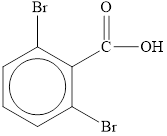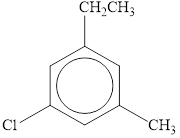
Study Guide with Student Solutions Manual for Seager/Slabaugh/Hansen's Chemistry for Today: General, Organic, and Biochemistry, 9th Edition
9th Edition
ISBN: 9781305968608
Author: Spencer L. Seager, Michael R. Slabaugh, Maren S. Hansen
Publisher: Cengage Learning
expand_more
expand_more
format_list_bulleted
Concept explainers
Textbook Question
Chapter 12, Problem 12.58E
Name the following by numbering the benzene ring. IUPAC-acceptable common names may be used where appropriate:
a. 
b. 
Expert Solution & Answer
Want to see the full answer?
Check out a sample textbook solution
Students have asked these similar questions
Draw out the SALCs of wach orbital in a AlCl3 molecule.
Which of the following is 3-ethyl-2-methylpentane?
х
Can you please help me with this problem and explain it step by step? I'm so confused about it
Chapter 12 Solutions
Study Guide with Student Solutions Manual for Seager/Slabaugh/Hansen's Chemistry for Today: General, Organic, and Biochemistry, 9th Edition
Ch. 12 - Prob. 12.1ECh. 12 - Define the terms alkene, alkyne, and aromatic...Ch. 12 - Select those compounds that can be correctly...Ch. 12 - Prob. 12.4ECh. 12 - Give the IUPAC name for the following compounds:...Ch. 12 - Prob. 12.6ECh. 12 - Prob. 12.7ECh. 12 - Prob. 12.8ECh. 12 - Prob. 12.9ECh. 12 - Prob. 12.10E
Ch. 12 - Prob. 12.11ECh. 12 - Prob. 12.12ECh. 12 - What type of hybridized orbital is present on...Ch. 12 - What type of orbital overlaps to form a pi bond in...Ch. 12 - Prob. 12.15ECh. 12 - Explain the difference between geometric and...Ch. 12 - Draw structural formulas and give IUPAC names for...Ch. 12 - Prob. 12.18ECh. 12 - Which of the following alkenes can exist as...Ch. 12 - Draw structural formulas for the following:...Ch. 12 - Prob. 12.21ECh. 12 - In what ways are the physical properties of...Ch. 12 - Prob. 12.23ECh. 12 - Prob. 12.24ECh. 12 - Complete the following reactions. Where more than...Ch. 12 - Prob. 12.26ECh. 12 - Prob. 12.27ECh. 12 - What reagents would you use to prepare each of the...Ch. 12 - What is an important commercial application of...Ch. 12 - Prob. 12.30ECh. 12 - Terpin hydrate is used medicinally as an...Ch. 12 - Prob. 12.32ECh. 12 - Prob. 12.33ECh. 12 - Prob. 12.34ECh. 12 - Prob. 12.35ECh. 12 - Much of todays plumbing in newly built homes is...Ch. 12 - Prob. 12.37ECh. 12 - What type of hybridized orbital is present on...Ch. 12 - How many sigma bonds and how many pi bonds make up...Ch. 12 - Prob. 12.40ECh. 12 - Explain why geometric isomerism is not possible in...Ch. 12 - Give the common name and major uses of the...Ch. 12 - Describe the physical and chemical properties of...Ch. 12 - Prob. 12.44ECh. 12 - Prob. 12.45ECh. 12 - Prob. 12.46ECh. 12 - Prob. 12.47ECh. 12 - Prob. 12.48ECh. 12 - Limonene, which is present in citrus peelings, has...Ch. 12 - A disubstituted cycloalkane such as a exhibits...Ch. 12 - Prob. 12.51ECh. 12 - Prob. 12.52ECh. 12 - Give an IUPAC name for the following as...Ch. 12 - Give an IUPAC name for the following as...Ch. 12 - Name the following compounds, using the prefixed...Ch. 12 - Name the following compounds, using the prefixed...Ch. 12 - Name the following by numbering the benzene ring....Ch. 12 - Name the following by numbering the benzene ring....Ch. 12 - Prob. 12.59ECh. 12 - Write structural formulas for the following:...Ch. 12 - Prob. 12.61ECh. 12 - Prob. 12.62ECh. 12 - Prob. 12.63ECh. 12 - Prob. 12.64ECh. 12 - Prob. 12.65ECh. 12 - Prob. 12.66ECh. 12 - Prob. 12.67ECh. 12 - Prob. 12.68ECh. 12 - Prob. 12.69ECh. 12 - Prob. 12.70ECh. 12 - Prob. 12.71ECh. 12 - Prob. 12.72ECh. 12 - Prob. 12.73ECh. 12 - Prob. 12.74ECh. 12 - Prob. 12.75ECh. 12 - Prob. 12.76ECh. 12 - Prob. 12.77ECh. 12 - Prob. 12.78ECh. 12 - Prob. 12.79ECh. 12 - Prob. 12.80ECh. 12 - Prob. 12.81ECh. 12 - Prob. 12.82ECh. 12 - Prob. 12.83ECh. 12 - The compound CH2=CHCH2CH2CH3 is an example of: a....Ch. 12 - The correct structural for ethyne is: a. HC=CH b....Ch. 12 - Prob. 12.86E
Knowledge Booster
Learn more about
Need a deep-dive on the concept behind this application? Look no further. Learn more about this topic, chemistry and related others by exploring similar questions and additional content below.Similar questions
- 2. Identify the reagents you would need to achieve the following. You may need to consider using a protecting group. HO 1. 2. 3. 4. 5. OH Br HOarrow_forwardBeF2 exists as a linear molecule. Which kind of hybrid orbitals does Be use in this compound? Use Orbital Diagrams to show how the orbitals are formed. (6)arrow_forwardPlease answer the questions and provide detailed explanations as well as a drawing to show the signals in the molecule.arrow_forward
- Propose an efficient synthesis for the following transformation: EN The transformation above can be performed with some reagent or combination of the reagents listed below. Give the necessary reagents in the correct order, as a string of letters (without spaces or punctuation, such as "EBF"). If there is more than one correct solution, provide just one answer. A. t-BuOK B. Na2Cr2O7, H2SO4, H2O C. NBS, heat F. NaCN D. MeOH E. NaOH G. MeONa H. H2O I. 1) O3; 2) DMSarrow_forwardStereochemistry Identifying the enantiomer of a simple organic molecule 1/5 Check the box under each structure in the table that is an enantiomer of the molecule shown below. If none of them are, check the none of t above box under the table. Br ま HO H 0 Molecule 1 Molecule 2 Molecule 3 OH H Br H H" Br OH Br Molecule 4 Br H OH + + OH Molecule 5 Br H OH none of the above Molecule 6 Br H... OHarrow_forwardPlease answer the questions and provide detailed explanations.arrow_forward
- Question 16 0/1 pts Choose the correct option for the following cycloaddition reaction. C CF3 CF3 CF3 CF3 The reaction is suprafacial/surafacial and forbidden The reaction is antarafacial/antarafacial and forbidden The reaction is antarafacial/antarafacial and allowed The reaction is suprafacial/surafacial and allowedarrow_forward1. Give the structures of the products obtained when the following are heated. Include stereochemistry where relevant. A NO2 + NO2 B + C N=C CEN + { 2. Which compounds would you heat together in order to synthesize the following?arrow_forwardExplain how myo-inositol is different from D-chiro-inositol. use scholarly sources and please hyperlink.arrow_forward
- What is the molarisuty of a 0.396 m glucose solution if its density is 1.16 g/mL? MM glucose 180.2 /mol.arrow_forwardProvide the proper IUPAC or common name for the following compound. Dashes, commas, and spaces must be used correctly. Br ......Im OHarrow_forwardCan you please help me solve this problems. The top one is just drawing out the skeletal correct and then the bottom one is just very confusing to me and its quite small in the images. Can you enlarge it and explain it to me please. Thank You much (ME EX1) Prblm #33arrow_forward
arrow_back_ios
SEE MORE QUESTIONS
arrow_forward_ios
Recommended textbooks for you
 Chemistry for Today: General, Organic, and Bioche...ChemistryISBN:9781305960060Author:Spencer L. Seager, Michael R. Slabaugh, Maren S. HansenPublisher:Cengage Learning
Chemistry for Today: General, Organic, and Bioche...ChemistryISBN:9781305960060Author:Spencer L. Seager, Michael R. Slabaugh, Maren S. HansenPublisher:Cengage Learning Introductory Chemistry: An Active Learning Approa...ChemistryISBN:9781305079250Author:Mark S. Cracolice, Ed PetersPublisher:Cengage Learning
Introductory Chemistry: An Active Learning Approa...ChemistryISBN:9781305079250Author:Mark S. Cracolice, Ed PetersPublisher:Cengage Learning Organic And Biological ChemistryChemistryISBN:9781305081079Author:STOKER, H. Stephen (howard Stephen)Publisher:Cengage Learning,
Organic And Biological ChemistryChemistryISBN:9781305081079Author:STOKER, H. Stephen (howard Stephen)Publisher:Cengage Learning, General, Organic, and Biological ChemistryChemistryISBN:9781285853918Author:H. Stephen StokerPublisher:Cengage Learning
General, Organic, and Biological ChemistryChemistryISBN:9781285853918Author:H. Stephen StokerPublisher:Cengage Learning

Chemistry for Today: General, Organic, and Bioche...
Chemistry
ISBN:9781305960060
Author:Spencer L. Seager, Michael R. Slabaugh, Maren S. Hansen
Publisher:Cengage Learning

Introductory Chemistry: An Active Learning Approa...
Chemistry
ISBN:9781305079250
Author:Mark S. Cracolice, Ed Peters
Publisher:Cengage Learning

Organic And Biological Chemistry
Chemistry
ISBN:9781305081079
Author:STOKER, H. Stephen (howard Stephen)
Publisher:Cengage Learning,

General, Organic, and Biological Chemistry
Chemistry
ISBN:9781285853918
Author:H. Stephen Stoker
Publisher:Cengage Learning

Chapter 4 Alkanes and Cycloalkanes Lesson 2; Author: Linda Hanson;https://www.youtube.com/watch?v=AL_CM_Btef4;License: Standard YouTube License, CC-BY
Chapter 4 Alkanes and Cycloalkanes Lesson 1; Author: Linda Hanson;https://www.youtube.com/watch?v=PPIa6EHJMJw;License: Standard Youtube License